A 13-month-old presents with fever, rash and congestion
Click Here to Manage Email Alerts
A 13-month-old male presents to a local ED with the chief complaint of fever and a rash. The history of the chief complaint was that the fever — 103.9·F at home — with nasal congestion and “wheezing” began 5 days earlier, with progressive worsening. The rash began today.
He was initially evaluated at a different ED in another town, where he was diagnosed with pneumonia and given a prescription for amoxicillin. However, so far, his parents have treated him with nebulized albuterol only, which he takes intermittently on a regular basis because his past medical history is positive for being a 25-week premature baby with some residual chronic lung disease. Otherwise, he had been doing well before this illness.

The rash at the current ED visit was described as vesicular, and because he had a temperature of 99.7·F with a respiratory rate of 45 breaths/min with some inspiratory stridor, he was referred for admission with the diagnosis of varicella and respiratory distress.
His immunizations are documented up-to-date, including influenza and monthly palivizumab (Synagis, MedImmune) for respiratory syncytial virus infection prophylaxis. He lives with his parents and extended family, some of whom have had upper respiratory tract infections recently. There is exposure to dogs and cats at home, but no recent travel.
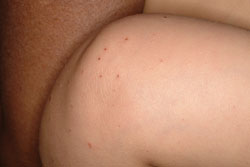 |
|
Figure 1: The rash was found only on his
extremities. |
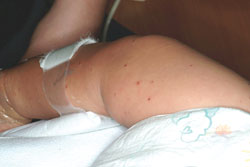 |
|
Figure 2: The rash consists of papular
lesions, with brownish-erythematous tops, some of which appeared to have a
small central crust. |
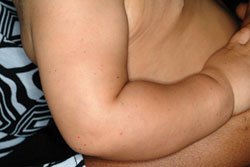 |
|
Figure 3: There was no surrounding erythema,
no vesicles seen, and no history of pruritus or evidence of excoriation.
|
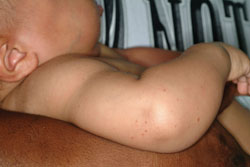 |
|
Figure 4 |
Examination on admission revealed vital signs with minimal tachypnea and no fever. He was noted to have some inspiratory stridor with agitation, but no significant distress. The only other positive finding was the rash that was found only on his extremities and consists of papular lesions, with brownish-erythematous tops, some of which appeared to have a small central crust (Figures 1-4). There was no surrounding erythema, no vesicles seen, and no history of pruritus or evidence of excoriation. His face and trunk are spared. Lab tests include a normal CBC and mildly elevated inflammatory markers (C-reactive protein and erythrocyte sedimentation rate), a negative rapid respiratory syncytial virus and influenza test, and a stable chest radiograph showing markings consistent with chronic lung disease, but no infiltrate.
What’s Your Diagnosis?
A. Pityriasis lichenoides et varioliformis acuta (PLEVA)
B. Varicella
C. Viral exanthem due to parainfluenza virus
D. Gianotti-Crosti syndrome
This is one of those bad questions you sometimes see on board exams in which more than one answer is right. Although viral exanthem could also be correct, this case is most consistent with a child with viral croup and Gianotti-Crosti syndrome (GCS; papular acrodermatitis). There’s no test to diagnose GCS, but rather having the characteristic rash (papular lesions as described in the exam above) that are restricted to the extremities, buttocks and, occasionally, the face, in the wake of a viral infection. Technically, any rash confined to the extremities as a reaction to an infection could be called GCS. For example, vesicular lesions are not typical but have been reported. The pathophysiology is unknown, but a variety of viruses have been associated with the rash, including parainfluenza virus; the most common cause of viral croup. Epstein-Barr virus is reported to be a common cause of GCS in this country, but in Europe and Japan, hepatitis B is thought to be the most common cause. There is no treatment for the rash needed, only reassurance. It typically resolves within a few weeks. Most cases are in young children, usually aged younger than 3 years. The disease was first described in the Italian literature by Agostino Crosti (1896-1988) and Ferdinando Gianotti (1920-1984) in Milan, Italy, in November 1957.
Lesions such as these can sometimes cause confusion in those less familiar with varicella. I have had several patients referred to our infectious diseases clinic with what was initially thought to be atypical varicella. They often turn out to have PLEVA; a papulosquamous disorder of unknown etiology, which causes similar-appearing lesions as GCS, only not restricted to the extremities and face. PLEVA lesions may consist of small vesicles in the early stage, but by the time we see them, they are usually papules that can have a crusty top with some erythema about the bases (Figures 5-6). Crops of PLEVA lesions may continue occurring for weeks to months, but usually require no treatment.
 |
|
Figure 5: PLEVA lesions are usually papules
that can have a crusty top with some erythema about the bases. |
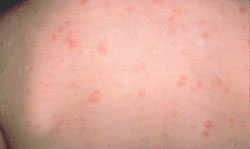 |
|
Figure 6: PLEVA lesions are usually papules
that can have a crusty top with some erythema about the bases. |
Varicella is usually not subtle. The lesions occur in crops covering the spectrum, from macules to papules to pustules and vesicles (Figure 7), and the patient is acutely ill with fever.
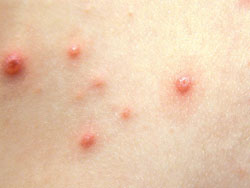 |
|
Figure 7: The lesions occur in crops
covering the spectrum, from macules to papules to pustules and
vesicles. |
What we usually think of as a viral exanthem is a rash on a patient with a viral illness. Of course, diseases — similar to measles and varicella — produce viral exanthems. Additionally, PLEVA and GCS may be loosely considered as viral exanthems, but the term is usually used in the context of a minor infection with a common maculopapular rash (Figure 8) that is temporally associated with the illness and requires no treatment.
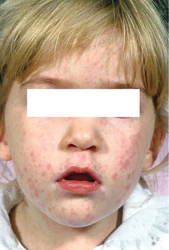 |
|
Figure 8: PLEVA and GCS may be loosely
considered as viral exanthems, but the term is usually used in the context of a
minor infection with a common maculopapular rash that is temporally associated
with the illness and requires no treatment. |
Columnist comments
To read more about these rashes, I recommend two books: William Weston’s 4th Edition (2007) Color Textbook of Pediatric Dermatology, for excellent, concise descriptions of all these conditions, or for an in-depth review, I use Lawrence Schachner and Ron Hansen’s 2011, 4th Edition Pediatric Dermatology. Both are excellent resources for the practicing primary care provider to have in their offices, as childhood rashes are a common and sometimes perplexing problem.
Lastly, I have featured numerous cases in this column from the first Gulf War, as well as some from the current conflict, and have often used this space to write commentary about military physicians, especially pediatricians in a combat environment. The current Iraq War began on March 20, 2003. Since then, as of this writing, 4,483 US military personnel have died there and tens of thousands have been wounded. Now, the troops, including our fellow physicians-in-arms, are out. Between the first Gulf War and now, many changes have taken place in Iraq. I have been back as a civilian twice in the past 5 years on medical education missions and have seen hopeful and optimistic Iraqi physicians who describe a much better country in which to live and practice medicine. Hopefully, the oldest civilization on Earth will remain stable, and history will show the results were worth the cost.
James H. Brien, DO, is a member of the Infectious Diseases in Children Editorial Board as well as Vice Chair for Education at The Children’s Hospital at Scott and White and is the Associate Professor of Pediatrics at Texas A&M University, College of Medicine, Temple, Texas. email: jhbrien@aol.com. Disclosure: Dr. Brien reports no relevant financial disclosures.
